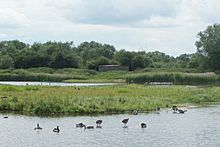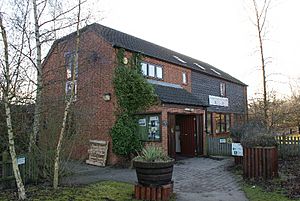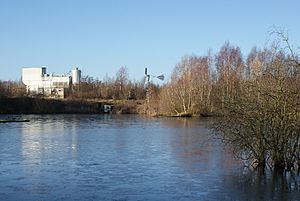Brandon Marsh facts for kids
| Site of Special Scientific Interest | |

East Marsh Pool with Willow Island in the foreground, July 2009
|
|
| Area of Search | Warwickshire |
|---|---|
| Interest | Biological |
| Area | 92 hectares |
| Notification | 1973 |
Brandon Marsh is a special nature reserve in Warwickshire, England. It's a place where nature is protected, called a Site of Special Scientific Interest (SSSI). You can find it next to the River Avon, close to the village of Brandon. It's just a few miles east of Coventry.
This reserve is also the main office for the Warwickshire Wildlife Trust. Long ago, this land was used for digging up sand and gravel. Now, the 92-hectare (228-acre) site belongs to a company called LaFarge Industries. They let the Trust use it to protect nature.
Today, Brandon Marsh has many different natural areas. You'll find old, flooded gravel pits, wet fens, bushy scrubland, reedbeds, and peaceful woodlands. Many of these habitats are rare in the local area. The reserve is super important for birds. Over 237 different kinds of birds have been seen here! Many birds come to breed, and others stay for the winter.
The reserve is also home to many different mammals and insects. You can find over 500 types of plants and more than 570 kinds of fungi. The nature reserve and its Visitor Centre are open every day for you to explore.
Contents
History of Brandon Marsh
The landscape of Brandon Marsh looks the way it does because of old gravel pits. But long ago, this area was farmland. The first pools formed in the 1940s and 1950s. This happened because of mining nearby, which made the ground sink.
Local nature lovers became interested in the site because of all the birds. By 1959, there was much more open water than there is now. Some of this water was lost when a company called Severn Trent Water cleaned out the area in 1963. Soon after, people started trying to protect the site.
The West Midlands Trust for Nature Conservation, with help from the West Midland Bird Club, worked to make it an SSSI. A group called the Brandon Marsh Conservation Group started in 1968. By 1973, Brandon Marsh was officially an SSSI. In 1981, the Warwickshire Wildlife Trust made a deal with Lafarge. They agreed to lease the land for 99 years for just £1 a year. This led to the creation of the nature reserve we see today.
The first bird hides were built in 1984. These hides looked over the East Marsh and Teal Pools. Digging for gravel stopped in 1989. By 1991, the Trust moved its main office to the site. They also built a small visitor centre.
More people started visiting the reserve, and it needed better facilities. So, in 1998, a brand new Visitor Centre opened. Sir David Attenborough himself opened it! It cost over £600,000 to build. Most of the money came from the Heritage Lottery Fund. Lafarge and Trust members also helped.
The Centre is open every day except Christmas Day. It has an Education Centre for school visits. There's also a conference centre, a tearoom, and a gift shop.
Exploring the Nature Reserve
The nature reserve is a huge area of wetlands and pools. There are many paths and trails for visitors to walk on. You can also use seven different bird hides to watch the wildlife. The plants and animals are very diverse. This is because there are so many types of habitats here. Many species found here are rare in other parts of the area.
Lots of bird species live here all year, or they stop during their long journeys. These include many types of ducks, geese, and wading birds. Brandon Marsh is one of the few large water areas around. This is why rare birds like osprey and whooper swan visit. It also has special habitats like reedbeds and woodlands close by.
In 2009 alone, 148 different bird species were seen. This included a woodchat shrike, which was the first ever seen in Warwickshire! 66 species also bred at the site. The reserve helps birds by having a nest box scheme. In 2009, 65 nest boxes were used, and 352 young birds hatched. This included two types of owls: barn owls and tawny owls.
Besides birds, the reserve also has many mammals. Most are common species. But otters have been seen, and they seemed to be around all of 2009. There's also an effort to bring back the endangered European water vole. However, they haven't always been successful, with no sightings in 2008 or 2009.
The reserve is a safe place for dragonfly and damselfly. Special areas are made just for them. In 2008, 16 species of dragonflies were recorded. Also, 24 types of butterflies and 220 kinds of moths were seen.
Plant life changes across the reserve depending on the habitat. As the reserve grows, new plant species are found regularly. Four new ones were found in 2008, and three in 2009. The many types of fungi are also due to the different habitats. Some fungi found here are not seen anywhere else in the region.
The Pools of Brandon Marsh
There are eight main pools at the reserve. Some are specially managed to help certain plants or animals. East Marsh Pool is the biggest, right in the middle of the reserve. It has two islands. Tern Island is made of gravel and pebbles. This attracts birds like common tern and little ringed plover to breed. There are also floating platforms on the pool. These help common terns breed, and eight pairs did so in 2008.
Willow Island is larger and grassy. It's a good spot for birds like lapwing, common redshank, and green sandpiper. The islands help protect nests from animals like foxes. Three hides overlook this pool. A special structure was built to attract sand martins to breed. This worked for the first time in 2009, with over 40 young birds hatching.
To the south are Teal Pool and River Pool. They were created in 1983. A dam was built between them so Teal Pool would hold water. This provides a home for dabbling duck species, like common teal and mallard. River Pool is larger and popular with wading birds, especially redshank and greenshank.
Central Marsh and Pool is a varied area. It has lots of common reed, reed sweetgrass, sedges, bulrushes, and teasel. Willow trees are very important here. They support over 250 kinds of insects. Alder trees are home to birds like redpoll, siskin, and various tit species.
Beyond Central Marsh is West Marsh Pool. This is a small water area surrounded by reedbed. Several dragonfly pools have been dug here. Plants that love damp areas, like marsh marigold and meadowsweet, grow well here.
Near the visitor centre are three more pools. Grebe Pool is named for the great crested grebes that breed there. Goose Pool was used by the gravel company to store water. So, its water level changes a lot. Swallow Pool was named because swallows used to roost there, but they don't anymore.
Reedbeds: A Special Habitat
The main reedbed at the site is called Newlands. It's a huge area at the eastern end of the reserve. With other areas in the West Marsh, the total reedbed area is about 25 hectares (61 acres). A wind-powered pump helps move water to irrigate another 9-hectare (22-acre) area near the Visitor Centre. This project is part of the UK Biodiversity Action Plan. The plan aims to create more reedbeds across the country.
The reedbeds are home to many acrocephalid warblers. These include the reed warbler, sedge warbler, and marsh warbler. Other birds like the grasshopper warbler also live here. It was the first place in the region where Cetti's warbler bred. There's a long-term goal to have the endangered Eurasian bittern breeding here. Bitterns have been seen regularly, with up to three birds sighted in late 2009. A new hide overlooking Newlands, named after volunteer Ted Jury, opened in 2014.
Other Habitats to Explore
New Hare Covert is a woodland area. It has mainly oak, ash, larch, and Scots pine trees. This area is managed to help biodiversity. It provides a home for many mammals, including muntjac. Woodland bird species also live here. Between New Hare Covert and Swallow Pool, there's a grassland area. This attracts many types of butterflies.
This area also has many small mammals. These include common shrew, field vole, and bank vole. These small animals attract birds of prey like the common kestrel and short-eared owl.
Horsetail Glade, as its name suggests, has a large area of giant horsetails. There are many willow species here. The beautiful common spotted orchid grows here in the summer.
Challenges at Brandon Marsh
Brandon Marsh is generally safe from pollution. The main challenge from people has been damage. In 2007, a fire started by some people destroyed a third of the Newlands reedbed. This was the second time the reedbed had been damaged by fire.
Most current challenges to the site's nature are natural. A constant problem is the invasive Japanese knotweed. This plant grows very thickly and blocks out local plants. Removing it takes a lot of time. The special liquid used to control it has to be put directly into its roots. This stops it from harming other plants.
Alder trees are also at risk from a fungal disease. This disease is caused by Phytophthora alni. Since it spreads through water, it could affect all the alders on the site. Another natural challenge is the introduced Harlequin ladybird. It was first seen here in June 2008. This ladybird is a big threat to the native seven-spot ladybird population. This is because it's very good at eating aphids, which both ladybirds rely on.
Mink sometimes visit the reserve. Humane traps are used to try and control them. Mink are a serious threat to birds that nest on the ground. Since they are strong swimmers, nests on the East Marsh islands are also at risk from them.
Images for kids






